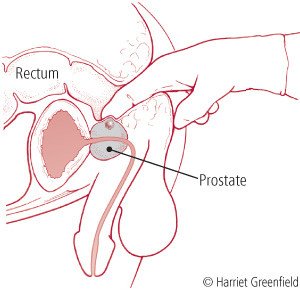Digital rectal exam
Medically reviewed by Drugs.com. Last updated on Dec 5, 2022.
What is a Digital rectal exam?

The digital rectal exam is a physical examination of the rectum, the last few inches of the bowel, just above the anus. The doctor uses a gloved and lubricated finger to check for abnormalities of the anus and rectum. It takes about one to two minutes and, although it may cause some mild discomfort, it should not be painful.
By feeling through the rectal wall, the doctor can also examine the surface of the prostate gland in men and some of the reproductive organs in women.

What it's used for
Doctors use the digital rectal exam to evaluate certain symptoms in both men and women. Usually these are symptoms affecting the digestive system, genitals, and urinary tract. For example, a doctor may do the exam to check the prostate in a man who complains of frequent urination or as part of the evaluation in a woman with abdominal or pelvic pain. Although the exam can detect some gynecological abnormalities in women, a vaginal (pelvic) exam is usually necessary.
During a rectal exam, your doctor also may obtain a small stool sample to test for bleeding from the stomach or bowels. However, testing for hidden blood in the stool as part of a digital rectal exam may not be as reliable as testing stool samples obtained during bowel movements at home.
In men that opt for prostate cancer screening, the rectal exam may be done in combination with a blood test for prostate-specific antigen (PSA test).
Preparation
There is no special preparation for a rectal examination.
How it's done
You will need to remove or pull down your clothing from the waist down and then lie on your side on an exam table with your knees pulled up toward your chest. Men can also have this exam performed in the standing position by bending over the exam table. Women having a pelvic exam can be examined while in the stirrups.
Your doctor will insert a gloved and lubricated finger into your rectum. It often helps to exert pressure as though you are moving your bowels. Your doctor will feel the wall of your rectum, checking for unusual lumps, swellings, or tenderness. In men, the doctor will feel the prostate gland through the wall of the rectum and check for suspicious nodules, as well as for abnormalities in the gland's size or shape. In women, the doctor may examine the rectum and vagina at the same time or separately.
Follow-up
Your doctor should be able to tell you the results of your exam before you leave. If your exam is not normal, your doctor can arrange follow-up testing.
Risks
The exam is a routine examination that is safe and causes little discomfort.
When to call a professional
Call your doctor if you feel any pain in your rectum or abdomen after your exam or if you notice any rectal bleeding.
Additional info
National Institute of Diabetes and Digestive and Kidney Diseases
https://www.niddk.nih.gov/
Further information
Always consult your healthcare provider to ensure the information displayed on this page applies to your personal circumstances.
